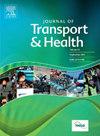You’ll Never Walk Alone: Parental active escorting as an alternative to car travel to school
IF 3.3
3区 工程技术
Q2 PUBLIC, ENVIRONMENTAL & OCCUPATIONAL HEALTH
引用次数: 0
Abstract
Introduction:
Active travel can contribute to children meeting recommended levels of physical activity. Independent travel may also increase children’s mental and emotional health by increasing feelings of autonomy. The purpose of this study is to determine (1) what predicts households’ joint choice of mode and parental escorting for the journey to school, and (2) how the structure of this joint choice is best described.
Methods:
Using data from the 2009 and 2017 National Household Travel Surveys in the United States, we estimated several discrete choice models jointly predicting the choice of mode and escorting. We tested alternative model structures representing mode-escorting combinations as independent alternatives, nested alternatives, or cross-nested alternatives.
Results:
The cross-nested model structure best fits the data. The cross-nested model is consistent with the conception of escorted active travel as a compromise between motorized travel and unescorted active travel. Lower vehicle access, a later survey year, and the presence of a nonworking mother in the household are associated with lower utility of both motorized travel and unescorted active travel, relative to escorted active travel.
Conclusions:
While the physical activity benefits of active travel are available regardless of parental escorting, additional mental and emotional health benefits may come when travel is both active and independent. Since there is less substitution from motorized travel to unescorted active travel than to escorted active travel, we conclude with a call for strategies that not only facilitate active travel to school, but also enable children to safely travel independently of their parents.
你永远不会独自行走:父母主动陪同作为开车上学的替代方案
导读:积极的旅行有助于儿童达到建议的身体活动水平。独立旅行也可以通过增加自主权来提高孩子的心理和情感健康。本研究的目的是确定(1)什么预测家庭共同选择的模式和父母陪同上学的旅程,以及(2)如何最好地描述这种共同选择的结构。方法:利用2009年和2017年美国全国家庭旅行调查的数据,我们估计了几个离散选择模型,这些模型共同预测了模式选择和陪同。我们测试了替代模型结构,将模式保护组合表示为独立替代、嵌套替代或交叉嵌套替代。结果:交叉嵌套模型结构与数据拟合最佳。交叉嵌套模型与护送主动出行的概念是一致的,它是机动出行和无护送主动出行之间的折衷。车辆较少、调查年份较晚以及家中母亲不工作与机动出行和无人陪同主动出行的效用较低相关。结论:尽管没有父母的陪伴,积极旅行对身体的好处是可以得到的,但当旅行既积极又独立时,心理和情感健康可能会得到额外的好处。由于从机动旅行到无人陪同的主动旅行的替代比有陪同的主动旅行少,因此我们呼吁制定策略,不仅促进主动旅行上学,而且使儿童能够安全地独立于父母旅行。
本文章由计算机程序翻译,如有差异,请以英文原文为准。
求助全文
约1分钟内获得全文
求助全文

 求助内容:
求助内容: 应助结果提醒方式:
应助结果提醒方式:


